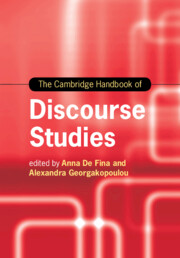Book contents
- The Cambridge Handbook of Discourse Studies
- Cambridge Handbooks in Language and Linguistics
- The Cambridge Handbook of Discourse Studies
- Copyright page
- Contents
- Figures
- Tables
- Contributors
- Preface
- Part I (Con)Textualizing Discourses
- Part II Perspectives and Modes of Analysis
- Part III Discourse Materialities and Embodiment
- 12 Multimodality
- 13 Sign Theory and the Materiality of Discourse
- 14 Discourse and the Linguistic Landscape
- 15 Discourse, Emotions and Embodiment
- 16 Posthumanism and Its Implications for Discourse Studies
- Part IV (Trans)Locations and Intersections
- Part V Ethics, Inequality and Inclusion
- Part VI Discourses, Publics and Mediatization
- Index
- References
14 - Discourse and the Linguistic Landscape
from Part III - Discourse Materialities and Embodiment
Published online by Cambridge University Press: 28 September 2020
- The Cambridge Handbook of Discourse Studies
- Cambridge Handbooks in Language and Linguistics
- The Cambridge Handbook of Discourse Studies
- Copyright page
- Contents
- Figures
- Tables
- Contributors
- Preface
- Part I (Con)Textualizing Discourses
- Part II Perspectives and Modes of Analysis
- Part III Discourse Materialities and Embodiment
- 12 Multimodality
- 13 Sign Theory and the Materiality of Discourse
- 14 Discourse and the Linguistic Landscape
- 15 Discourse, Emotions and Embodiment
- 16 Posthumanism and Its Implications for Discourse Studies
- Part IV (Trans)Locations and Intersections
- Part V Ethics, Inequality and Inclusion
- Part VI Discourses, Publics and Mediatization
- Index
- References
Summary
Research into the way that linguistic and other semiotic signs are displayed in public space has opened up a productive field for social language analysis. Often focused on the policy implications of public signage, at both institutional and grassroots levels, linguistic landscape research has, from the very beginning, engaged with issues of politics, ideology and cultural representation and thus, indirectly, discourse. In recent years, it has also begun to theorize the material experience of landscapes and the ways in which semiotic artifacts and practices generate meaning by interacting in explicitly dialogical ways. To date, however, theorizing that is directed specifically at the relationship between linguistic landscape studies and discourse studies has been slight. This chapter explores the nature of this relationship by focusing on select case studies that exemplify the ways in which acts of linguistic and semiotic display in the public arena operate as key sites for political regulation and contestation and as sites of affect. These short case studies also examine how meaning is generated through the complex layering of contexts, the interplay between multiple signs, the narrative and affective potential of landscapes and the dialogic possibilities presented by social media. This discourse-based approach to linguistic landscapes allows insights into how local meanings get upscaled and reconfigured, pulling site-specific semiotic events into much broader discourses and materialities.
- Type
- Chapter
- Information
- The Cambridge Handbook of Discourse Studies , pp. 306 - 326Publisher: Cambridge University PressPrint publication year: 2020
References
Further Reading
This case study of the linguistic landscape of Antwerp, Belgium explores the way in which multilingual signs chronicle the complex histories of a place.
This is an important collection about linguistic landscapes, with a focus on language and visual discourse and on spatial practices.
This classic text explores the ways in which the meaning of public texts is dependent on a rich understanding of the social and physical context in which they exist.
This is one of the earliest collections of linguistic landscape research; it gives a good overview of the scope of the field.
References
- 5
- Cited by



